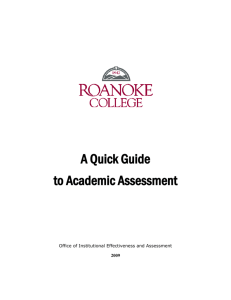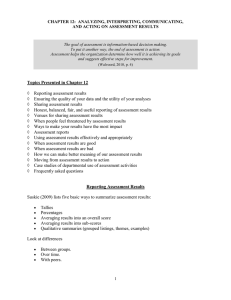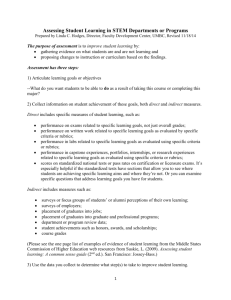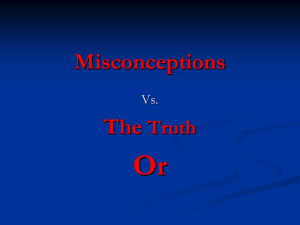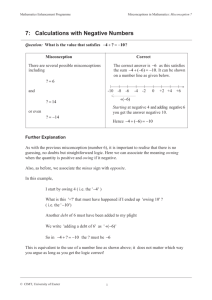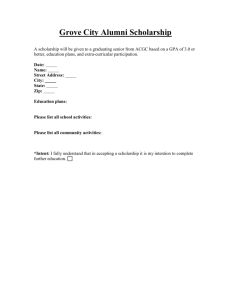Motivating Colleagues to Participate in Assessment
advertisement
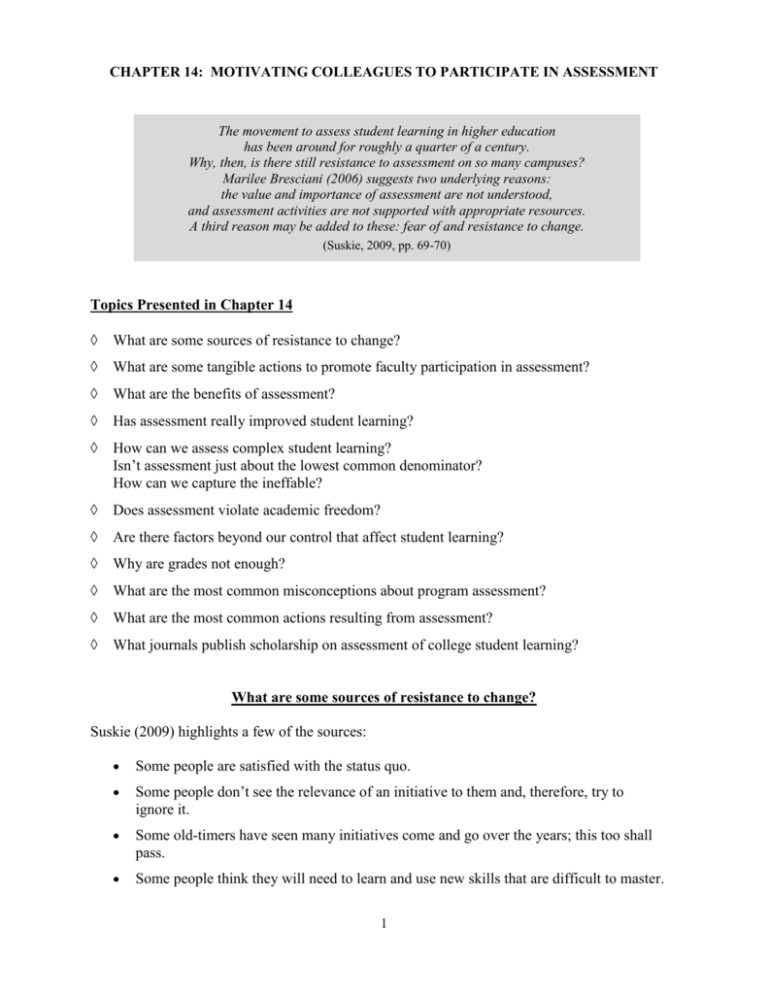
CHAPTER 14: MOTIVATING COLLEAGUES TO PARTICIPATE IN ASSESSMENT The movement to assess student learning in higher education has been around for roughly a quarter of a century. Why, then, is there still resistance to assessment on so many campuses? Marilee Bresciani (2006) suggests two underlying reasons: the value and importance of assessment are not understood, and assessment activities are not supported with appropriate resources. A third reason may be added to these: fear of and resistance to change. (Suskie, 2009, pp. 69-70) Topics Presented in Chapter 14 What are some sources of resistance to change? What are some tangible actions to promote faculty participation in assessment? What are the benefits of assessment? Has assessment really improved student learning? How can we assess complex student learning? Isn’t assessment just about the lowest common denominator? How can we capture the ineffable? Does assessment violate academic freedom? Are there factors beyond our control that affect student learning? Why are grades not enough? What are the most common misconceptions about program assessment? What are the most common actions resulting from assessment? What journals publish scholarship on assessment of college student learning? What are some sources of resistance to change? Suskie (2009) highlights a few of the sources: Some people are satisfied with the status quo. Some people don’t see the relevance of an initiative to them and, therefore, try to ignore it. Some old-timers have seen many initiatives come and go over the years; this too shall pass. Some people think they will need to learn and use new skills that are difficult to master. 1 Some people feel threatened by a new initiative. Some people have misconceptions about a new initiative. The prospect of change means the prospect of more work. What are some tangible actions to promote faculty participation in assessment? Walvoord (2010) suggests doing the following to encourage your faculty members’ participation in assessment: Devote at least two hours in one or more faculty meetings each year to discuss what faculty members in each program expect students to be able to do when they graduate, how you know whether or not students have achieved this, and what you could try to address weaknesses. Ask each faculty member who regularly teaches the same courses to bring copies of one of his or her syllabi to share with colleagues. Discuss what expectations the faculty member has for the course, what weaknesses he or she sees in student preparation, and how this course fits in with others in the curriculum. Adapt faculty performance expectations (or recognize them if they are already there) to explicitly acknowledge participation in assessment of student learning. Recognize the scholarship of teaching and learning as a legitimate and important part of research in the department. Reward faculty members who receive grant funding (OIE supplies this!), who make conference presentations, and who publish concerning teaching and learning in the discipline. (See the list of journals that publish on the scholarship of teaching and learning at the end of this chapter.) What are the benefits of assessment? In general, benefits include getting faculty members, within and across disciplines, talking about their goals for student learning, seeing how courses fit together, making expectations more clear to students, and sharing detailed feedback with students. (Suskie, 2009; University of Delaware, n.d.; Wolvoord, 2010) In general, assessment: Increases our confidence that we are putting our time and resources into activities that we value as an institution. Increases our confidence that we are allocating resources to areas that are producing the outcomes we value. Gathers and uses data that will enable us to make decisions that lead to improved instruction, stronger curriculums, and effective and efficient policies. Strengthens our ability to say that our graduates are well-prepared to succeed in their future endeavors. 2 Has ready access to data that will satisfy the requirements of accrediting agencies and funding agencies, and will inform various accountability driven conversations. Gathers and uses data that will strengthen arguments for increased funding and/or resource allocations to areas that are producing valued outcomes. Increases the effectiveness of our communications about the value of a university education. Has assessment really improved student learning? Yes, according to Suskie and Walvoord. There is an abundance of literature about how assessment has improved student learning within specific disciplines and within specific institutions. For example, see Banta, Jones, and Black (2009); Bresciani (2006); Maki (2010); Peterson and Einarson (2001) in addition to journals listed at the end of this chapter and issues of Assessment Update http://www.josseybass.com/WileyCDA/WileyTitle/productCd-AU.html. How can we assess complex student learning? Isn’t assessment just about the lowest common denominator? How can we capture the ineffable? Walvoord says that we should be spending our time in assessment concentrating on what really matters most. This is not easy, but it is not impossible. We need to figure out how to effectively evaluate what students do that reflect our goals for them. Many people have been thinking about this, both within and across disciplines. Is your national disciplinary professional association talking about this? An excellent resource for assessment of cross-disciplinary, liberal education college student learning is the Association of American Colleges and Universities (AAC&U) LEAP (Liberal Education and America’s Promise) and VALUE (Valid Assessment of Learning in Undergraduate Education) projects. (See http://www.aacu.org/LEAP and http://www.aacu.org/value.) Does assessment violate academic freedom? The Association of American Colleges and Universities’ Board of Directors Statement on Academic Freedom and Educational Responsibility (2006) directly addresses this question: There is, however, an additional dimension of academic freedom that was not well developed in the original principles, and that has to do with the responsibilities of faculty members for educational programs. Faculty members are responsible for establishing educational goals for student learning, for designing and implementing programs of general education and specialized study that intentionally cultivate the intended learning, and for assessing student achievement. In these matters, faculty members must work collaboratively with colleagues in their departments, schools, and institutions as well as with relevant administrators. Academic freedom is necessary not just so faculty members can conduct their individual research and teach their own courses, but so they can enable students—through whole college programs of study—to acquire the learning they need to contribute to society. 3 Are there factors beyond our control that affect student learning? Walvoord says that of course there are! Acknowledge factors that you cannot control, such as students’ incoming skill levels or the number of hours they spend in their jobs, to establish beginning points for student assessment and to provide a context for learning. Why are grades not enough? Suskie and Walvoord list the following reasons: Course grades usually tell us something about how an individual student knows relative to other students in the same course section, but provide no details about exactly what that student actually knows or doesn’t know. If grades reflect attendance, this does not tell us much about student learning. If multiple sections of a class are offered and taught by different people, are the content and grading criteria exactly the same? Grades for individual assignments are typically not available to anyone else besides the instructor and the student. A degree program should be more than a set of disparate courses. Are there things we want students to know and be able to do that span multiple courses? Do we really know how each course fits into a coherent curriculum? What are the most common misconceptions about program assessment? The University of Central Florida (2008, pp. i-11) lists seven: Misconception 1: The results of assessment will be used to evaluate faculty performance. Nothing could be further from the truth. Faculty awareness, participation, and ownership are essential for successful program assessment, but assessment results should never be used to evaluate or judge individual faculty members’ performance. The results of program assessment are used to improve programs. Misconception 2: Our program is working well, our students are learning; we don’t need to bother with assessment. The primary purpose of program assessment is to improve the quality of educational programs by improving student learning. Even if you feel that the quality of your program is good, there is always room for improvement. In addition, various accrediting bodies mandate conducting student outcomes assessment. Not to conduct assessment is not an option. Misconception 3: We will assign a single faculty member to conduct the assessment. Too many opinions would only delay and hinder the process. While it is a good idea to have one or two faculty members head the assessment process for the department, it is really important and beneficial to have all faculty members involved. Each 4 person brings to the table different perspectives and ideas for improving the academic program. Also it is important that all faculty members understand and agree to the mission (i.e., purpose) and goals of the academic program. Misconception 4: The administration might use the results to eliminate some of the department’s programs. There are two types of evaluation processes: summative and formative. The purpose of summative program evaluation is to judge the quality and worth of a program. On the other hand, the purpose of formative program evaluation is to provide feedback to help improve and modify a program. Program assessment is intended as a formative evaluation and not a summative evaluation. The results of program assessment will not be used to eliminate programs. Misconception 5: Assessment is a waste of time and does not benefit the students. The primary purpose of assessment is to identify the important objectives and learning outcomes for your program with the purpose of improving student learning. Anything that enhances and improves the learning, knowledge, and growth of your students cannot be considered a waste of time. Misconception 6: We will come up with an assessment plan for this year and use it every year thereafter. For program assessment to be successful, it must be an ongoing and continuous process. Just as your program should be improving, so should your assessment plan and measurement methods. Each academic department must look at its programs and its learning outcomes on a continual basis and determine if there are better ways to measure student learning and other program outcomes. Your assessment plan should be continuously reviewed and improved. Misconception 7: Program assessment sounds like a good idea, but it is time-consuming and complex. It is impossible to “get something for nothing.” Effective program assessment will take some time and effort, but there are steps that you can follow that can help you to develop an assessment plan that will lead to improving student learning. What are the most common actions resulting from assessment? According to Walvoord, you can expect the following actions from your assessment: Changes to the curriculum, requirements, programmatic structures, or other aspects of students’ course of study Changes to the policies, funding, and planning that support learning Faculty development 5 What journals publish scholarship on assessment of college student learning? Suskie provides the following lists of journals that cover topics of general interest in higher education and teaching in the specific disciplines. General Interest Higher Education Publications American Educational Research Journal American Journal of Evaluation Applied Measurement in Education Assessment and Evaluation in Higher Education Assessment in Education: Principles, Policy and Practice Assessment Update Change College Teaching Community College Journal of Research and Practice Computer Supported Cooperative Work: The Journal of Collaborative Computing Educational Action Research Educational Evaluation and Policy Analysis Educational Policy Analysis Archives Educational Research Innovations in Education and Teaching International Innovative Higher Education Interactive Learning Research International Journal for the Scholarship of Teaching and Learning Journal of College Student Retention Journal of Educational Measurement Journal of Excellence in College Teaching Journal of Graduate Teaching Assistant Development Journal of Higher Education Journal of Student-Centered Learning Liberal Education National Teaching and Learning Forum New Directions for Higher Education New Directions for Program Evaluation New Directions for Teaching and Learning Peer Review Practical Assessment, Research, and Evaluation Research in Higher Education Teaching Excellence Teaching Professor 6 Journals on Teaching in a Specific Discipline American Biology Teacher Biochemical Education Chemical Engineering Education College Composition and Communication College Mathematics Journal Communication Education History Teacher Journal of Accounting Education Journal of Agricultural Education Journal of Chemical Education Journal of College Science Teaching Journal of Criminal Justice Education Journal of Economic Education Journal of Engineering Education Journal of Environmental Education Journal of Geography in Higher Education Journal of Geoscience Education Journal of Health Education Journal of Management Education Journal of Marketing Education Journal of Nursing Education Journal of Social Work Education Journal of Teaching in Physical Education Journal of Teaching in Social Work Journal of Teaching Writing Journalism and Mass Communication Educator Mathematics and Computer Education Mathematics Teacher Physics Teacher Research in Collegiate Mathematics Education Research on Science Teaching Research Strategies: A Journal of Library Concepts and Instruction Schole: A Journal of Leisure Studies and Recreation Education Studies in Higher Education Teaching English in the Two-Year College Teaching in Higher Education Teaching of Psychology Teaching Philosophy Teaching Sociology Trends and Issues in Postsecondary English Studies 7
